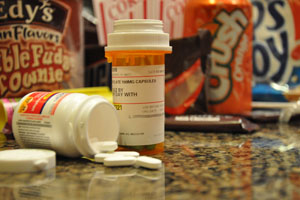Human tongues are cleverly hard-wired to enjoy certain foods that were once, before the age of grocery stores, sometimes quite hard to come by. According to his article ‘Physiology of Taste’, to the body ‘sweet’ indicates a food that is high in energy producing nutrients while ‘umami’, a Japanese term for something similar to savory, is associated with important amino acids in food such as meat, said Dr. Richard Bowen professor of biomedical science. On the other hand, ‘bitter’ is the taste of many plant toxins, and recognition of the flavor acted as a protection mechanism. In a previous time, an acute sense of taste was the driving power behind humans getting their daily nutrition. Even though steak and chocolate bars can now be found in the same building, the cravings for and enjoyment of sugary treats and fat-laden meats isn’t subsiding, leaving teens open for an array of medical issues caused by an unbalanced diet.
At home teens are on their own with food choices, but at least at school the cafeteria provides balanced meals with multiple options. Still, students have the final say in what’s on their tray. Taking eight chicken strips when only three are recommended and skipping the sides can’t give your body the nutrients it needs.
“I would encourage kids to take the time to get the fruits and vegetables that come with the meal,” Blue Valley dietitian Sarah Chellberg said. “We are trying hard to put the variety out there, but we need the kids to pick them up.”
The optional sides in the lunch room are often the source of much needed nutrients and vitamins. Iron, calcium and vitamins A and C are now considered ‘shortfall’ because many teens lack the recommended amount in their diets. Without these small molecules, seemingly unrelated but dangerous issues can develop. Depriving your body is obviously risky to yourself, but it can easily become a threat to those around you as well.
“Vitamins from fruits and vegetables take care of other things in the body that you might not realize,” Chellberg said. “They can cause low energy, double vision and poor vision for night driving.”
Because eating habits develop over time, it seems easiest to grab a slice of pizza and a Gatorade in the lunch room, or head to a restaurant and order a #8 with extra fries. Fried, sugary and salty foods, though they are easy on the tongue, are hard on the rest of the body. It’s stressful for systems to have to function under stress and fatigue from sudden rushes of sugar, fats and carbohydrates. Day-to-day intake of only processed foods destroy the body’s inner balance and weakens all its systems, leading to critical issues in the future.
“For kids in the U.S., high cholesterol and high triglycerides can lead to heart disease,” Blue Valley Southwest nurse Jill Stevens said. “Juvenile-onset diabetes is also a concern.”
Cardiovascular problems, or issues with the heart system, frequently result from poor eating habits. The issue results from buildup or deposits of fat and cholesterol in the arteries, which restrict blood flow to the heart. Often, delicate surgery or even transplants are needed to reverse the issue, if it is not fatal.
According to the United States Center for Disease Control (CDC), “Heart disease is the leading cause of death in the United States and is a major cause of disability … About every 25 seconds, an American will have a coronary event, and about one [American] every minute will die from one.”
Teens are also susceptible to both Type 1 and Type 2 diabetes, both of which require severe life style monitoring and either frequent pills or daily injections. Type 2 diabetes is linked to being overweight, but the complications of the disease include much more than just physical stature.
According to the National Diabetes Education Program, “[Diabetes] can also damage organs in the body and cause blindness, kidney failure, loss of toes or feet, gum problems, or loss of teeth.”
Often times, society contradicts itself in the food industry. The pressure is on to have a tiny body, especially for girls, but fast food chains implement tactics like serving massive portions for less money to draw customers. It seems hard to balance the right food in the right portions, so unfortunately many students turn to skipping a meal to reduce fat or caloric intakes.
“To all the breakfast skippers: eating breakfast will stimulate the metabolism at the start of the day and it will burn higher throughout the day,” Chellberg said. “Even to the girls who ‘aren’t hungry’, just try and get your metabolism up and running with a cheese stick or GoGurt.”
Depriving the body of the morning meal for vanity or even for the sake of time is a straight shot to destroying academic and athletic performance, plus it creates a ravenous afternoon appetite. Even those who eat downsized portions or snacks can’t be at their best for long.
“We want snackers at lunch to understand that if they could have anything at lunch with protein it will fill them up and last through the day,” Chellberg said. “Chips and a drink will spike your blood sugar, but then it will crash and the student will be so tired that they just want to go home and take a nap. Eating something with protein won’t give them the let down later.”
Being healthy requires some forethought, but it’s not an impossible task. Considering the types and amounts of food you get each day and not succumbing to every craving is the way to have an energized body and maintain long-term health.
“Students think [eating healthy] is about the calories when it’s really just about balancing their diet,” Chellberg said.








